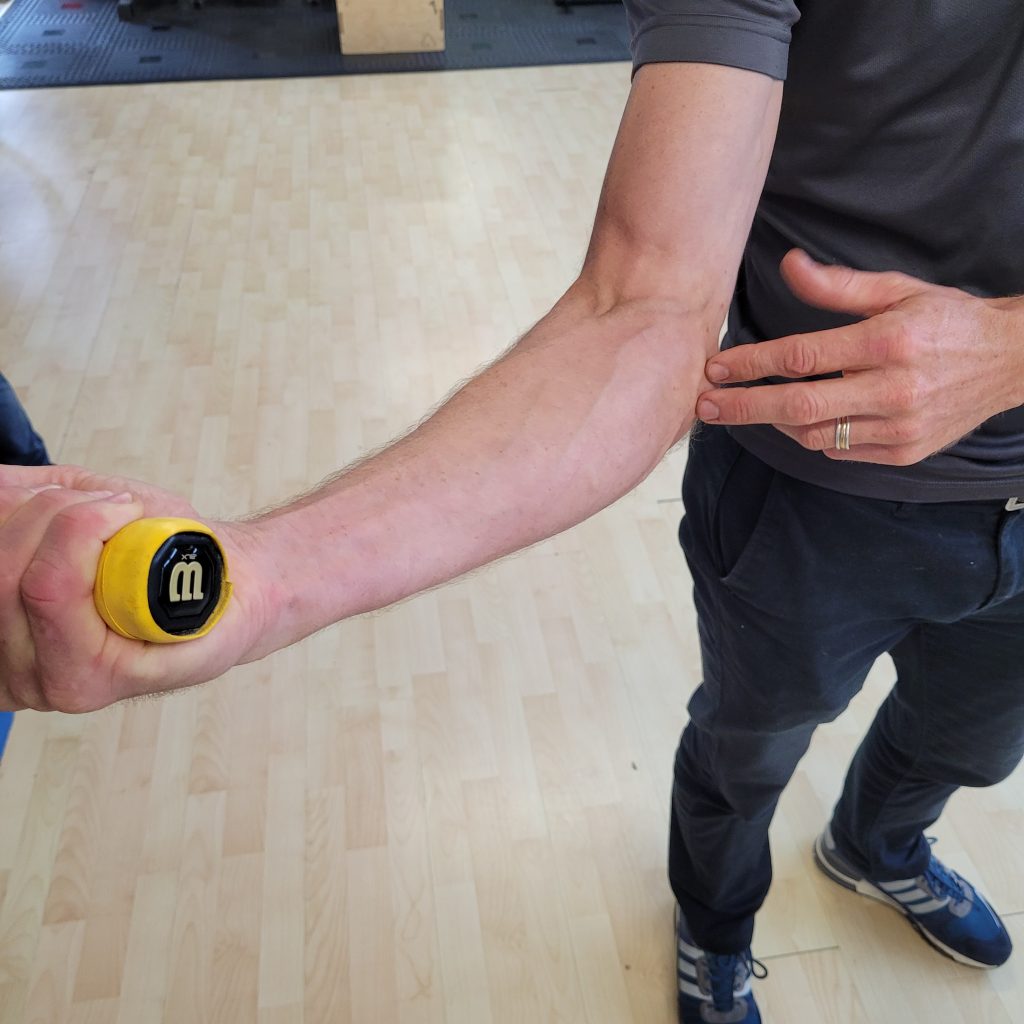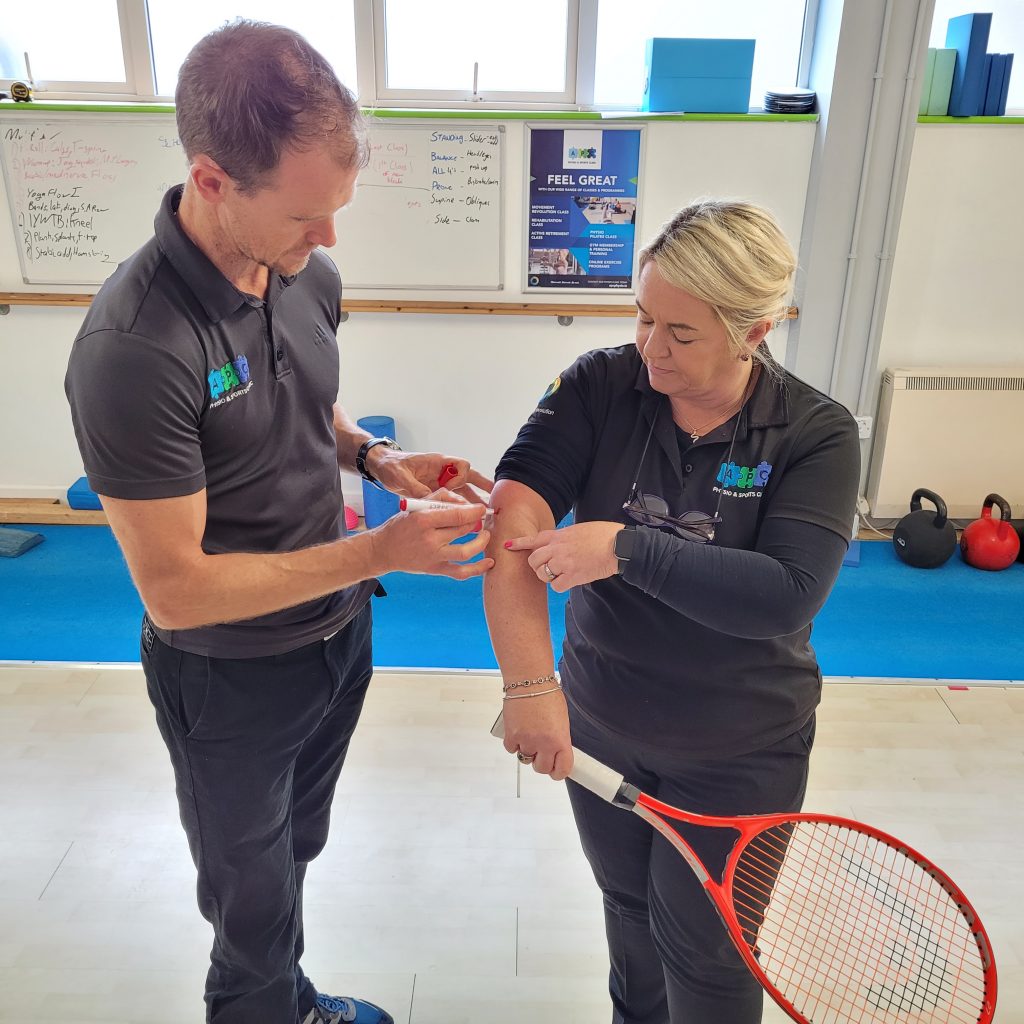Elbow Pain Can Often Be The Knock On Effect Of Something Else
Being someone who has played racquet sports for over thirty years I know what it is like to have to deal with the frustration of having elbow pain.

It never starts at the right time, can really affect your ability to play and takes the enjoyment out of the game.
Here are a few sure fire tips to take onboard if you are someone who struggles with elbow pain. Some of these principles could also relate to a tradesperson with elbow pain .You don’t need to play Tennis to have Tennis Elbow (lateral elbow pain) or Golf to have Golfer’s elbow (medial elbow pain).
Grip Strength:
Elbow pain can significantly impact grip strength. This can have knock-on effects to every other part of your life, not just playing your chosen sport be it Golf, Tennis, Squash, Badminton, Racquetball and even work.
Elbow pain can occur on either the outside of the upper forearm, which is called Tennis Elbow or Lateral Epicondylitis or Golfer’s Elbow, or on the inside of the upper forest arm, otherwise called Medial Epicondylitis.
Both of these issues are often attributed to a few things, namely tissue overload or weak kinetic chain.

Tissue overload:
Tissue overload is a very simple and often overlooked concept. When a body part gets overworked the tissues (muscle, tendon, or joint) can get overloaded and result in a pain experience. The main reason for this is that the body part, let’s use the outside elbow in this example, gets overloaded resulting in the wrist extensor muscles getting tight and painful.
The overload has happened because of one of two things, ‘Too much too soon syndrome’ or more commonly due to compensation for a weakness elsewhere in the body.
If we take the example of the person who has only recently started back playing tennis after years away from the game. They start back with the best intentions and a positive gung-ho attitude and play three times a week for the first five weeks and then their lateral elbow pain starts. It is can be sharp when hitting the ball and the arm feels weak.
This pain problem has simply happened because there hasn’t been enough time for the body to recover after the strain loads placed on it from each session. The result then is an overload to tissues that are gradually getting stressed beyond their current capacity.
If we take the example of the person who has only recently started back playing tennis after years away from the game. They start back with the best intentions and a positive gung-ho attitude and play three times a week for the first five weeks and then their lateral elbow pain starts. It is can be sharp when hitting the ball and the arm feels weak.
This pain problem has simply happened because there hasn’t been enough time for the body to recover after the strain loads placed on it from each session. The result then is an overload to tissues that are gradually getting stressed beyond their current capacity.

So what’s the solution?
Cut back to once or twice a week , if pain allows, until the body heals and then allow time to build back up the desired three times per week. Get the body fit and strong be engaging in an exercise class or doing a suitable home exercise programme.
Compensations can have knock-on effects elsewhere in the body
So if we use Angela’s case of elbow pain that is due to a weakness in the rotator cuff muscles of the shoulder.
Angela has always worn an elbow brace for her elbow pain than ‘just never goes away’ despite massage, rest and anti inflammatory medication.
She loves to play two to three times per week and it is her way of socialising and keeping fit but sometimes if the pain becomes too much she is forced to stop for weeks at a time.
This is a common story we see in clinic of people with a compensation type pattern.
The thing to note here is that Angela (53) had a bad fall thirteen years ago which resulted in a shoulder injury to her joint and rotator cuff. She was in a sling for four weeks and was advised to get back into normal activities whenever she felt able.
So in Angela’s case the elbow is taking the brunt of the stress ( compensating) because the rotator cuff muscles of the shoulder are not doing their fair share of the work. The old shoulder injury has caused a weakness that is the weak link.
Can this actually be the case thirteen years later?
Yes.
This is very possible, especially if no specific rehabilitation plan was followed.
This ‘compensation’ principle can be applied to any body part and it is worth noting that a weak back or leg injury can also affect the upper body.
Racquet Handle Size:
Racquet handle size is important to consider. The size of the grip will influence grip strength and more importantly it can either positively or negatively put the grip muscles in a favourable or unfavourable position. This is called ‘length tension’ where the muscle fibres are placed in an optimal position, where they can function well, every time, over a long time.
Grip Technique:
The way the racquet is gripped in the hand is critical to so many elements of one’s game as well as the effect on the body.
Ensuring your style of grip is appropriate for the type of racquet, your mechanics and style of play are important to consider so ask an experienced club member or coach.
If you make changes to your grip it is advisable to ease off on the number and intensity of sessions until you are confident the body can tolerate these new stress loads.
Then it is ok to start building back up again to a normal training load.
So these are just a few simple pointers to help you or a friend with arm pain.
Move Well , Feel Well, Be Well.
If you need further assistance please give us a call and we will happily do a full injury history and full body assessment.
From here we will provide treatment and specific rehabilitation exercises to get you back on track.